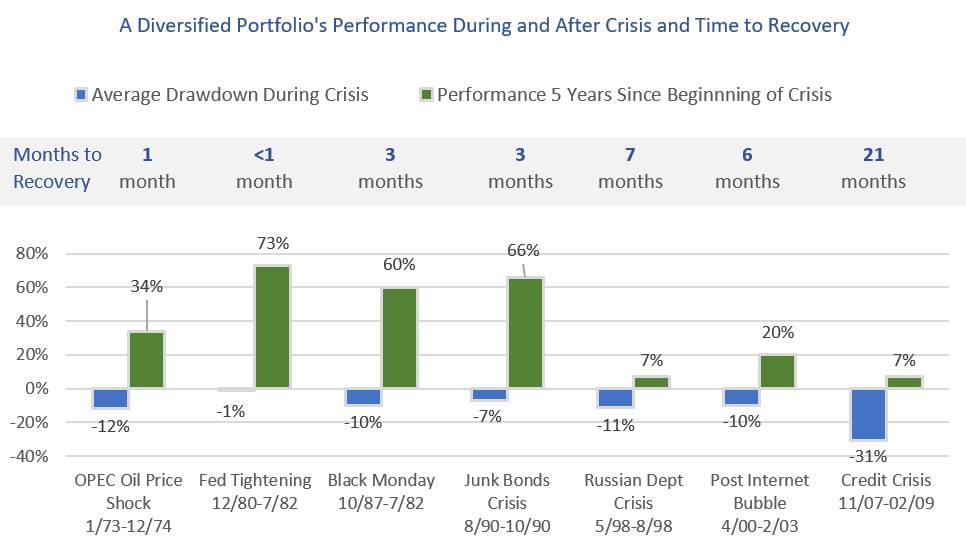Let’s say you are the unluckiest investor in the world. You come into money and decide to invest in a well-diversified portfolio (10% cash, 28% bonds, 42% global equities, 20% alternatives). However, you unknowingly do so at the absolutely worst times possible in the last forty five years, meaning immediately prior to the onset of the seven worst markets in that period (including Black Monday, the dot-com implosion, and the 2008 Global Financial Crisis).
Well, you’d undoubtedly feel terribly unlucky in the near term and would question your strategy (and perhaps sanity!). But what if you did nothing, letting your investments ride for the next five years?
The results are startling: In all seven periods your portfolio made money despite its poor start, with an average gain of 38% over the five year period. The average drawdown was 12% (not pleasant but hardly disastrous), and it took an average of less than six months from peak drawdown to regain all of the initial losses.

Diversified Portfolio: 10% cash, 28% bonds, 42% global equities, 20% alternatives. Source: Tiedemann Advisors, Bloomberg
Just doing nothing could lead to perfectly acceptable returns in every worst-case starting scenario. Sure, returns could have been better if you’d had the foresight to sell before the drop and buy at the bottom. However, the ability to time markets has proven to be virtually impossible for even the most astute investor, particularly when this would require the ability to accurately do so twice: first to know when to sell, and second to know when to buy back in.
The implications of this are clear:
- Investors are overly concerned with market drawdowns that inevitably happen over time.
- Sticking to a well-structured investment discipline works, even (or particularly) in difficult times.
- It’s more important in the long run to be invested than to try to time when to be invested.
If volatility isn’t the enemy of the long-term investor, what is?
The permanent loss of capital due to the realization of losses. While that’s an entire subject in itself, here are the primary causes of permanent losses and ways to avoid them from occurring:
- Insufficient Liquidity. Lack of the liquidity needed to fund lifestyle and other obligations can create the need for forced assets sales during down markets. Hold sufficient liquidity to get you thru 12-18 months of needs.
- Bad Investments. This can be caused by a lack of due diligence, impulsive behavior, or relying on poor counsel. Ensure that you have a qualified advisor and limit your exposure to any single strategy or manager.
- Overpaying for assets. Ensure that you’re paying a fair price for the expected return of an asset and rebalance your portfolio regularly.
This information is provided to discuss general market activity, industry or sector trends, or other broad-based economic, market or political conditions. This material is for informational purposes only, is not a solicitation and no action is being solicited based upon it. It does not take into account the particular investment objectives, restrictions, tax and financial situation or other needs of any specific client. This material is based upon information which we consider reliable, but we do not represent that such information is accurate or complete, and it should not be relied upon as such. Information and opinions are as of the date of this material only and are subject to change without notice. ©March 2018 Tiedemann Advisors